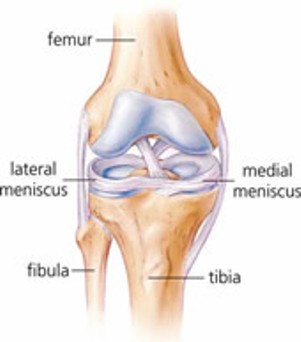What is Knee meniscus?
 The knee joint is made up of three bones, the femur (thigh bone), the tibia (shin bone) and the patella (knee cap). The knee joint is a hinge joint allowing two principal actions flexion (bending) and extension (straightening). The meniscus is “C shaped” discs made of tough cartilage called fibrocartilage. They are located on the tibial plateau (top surface of the tibia) between the tibia (shin bone) and the femur (thigh bone).
The knee joint is made up of three bones, the femur (thigh bone), the tibia (shin bone) and the patella (knee cap). The knee joint is a hinge joint allowing two principal actions flexion (bending) and extension (straightening). The meniscus is “C shaped” discs made of tough cartilage called fibrocartilage. They are located on the tibial plateau (top surface of the tibia) between the tibia (shin bone) and the femur (thigh bone).
There is a lateral meniscus which is located on the outside of the knee joint, and a medial meniscus located on the inside of the knee joint. The meniscus plays a role in joint stability by creating a cup for the femur to sit in, and also act as a shock absorber for the knee by spreading compression forces from the femur over a wider area on the tibia. This function helps to protect the underlying joint surface cartilage that lines the bone surfaces from wearing out and developing degenerative arthritis.
The meniscus itself is mostly avascular, meaning it does not have blood vessels inside, except at the periphery (outer surface) where it joins to the vascular knee joint lining providing the outermost 20% of the meniscus with a blood supply. As a result of the avascularity, the meniscus does not have the ability to heal itself unless the tear is small and in the peripheral (outer) vascular zone.
Two mechanisms for tearing a meniscus are:
- Traumatic tears – usually occur from a sudden load on the meniscus causing failure of the meniscal tissue usually involving a twisting injury, where the knee is bent and forcefully twisted whilst the leg is in a weight-bearing position.
- Degenerative tears are failure of the meniscal tissue over time. There is a natural drying out of the inner centre of meniscus with age from late 20s and progressing with age. The meniscus becomes less compliant and less elastic and may tear with minimal trauma such as getting into a squat position.
In next week’s blog, we will discuss more on meniscal injury and classification of tears.
